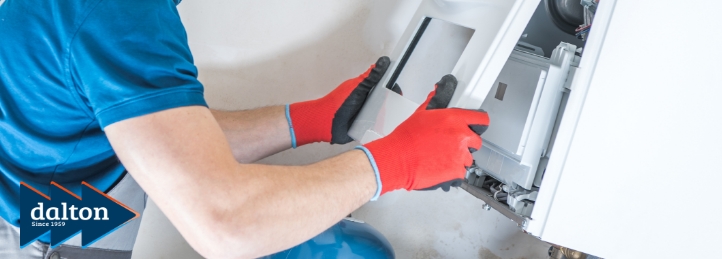Heating Services in Cedar Falls and Waterloo, IA

When the Iowa winter strikes with full force, reliable heating becomes more than a luxury—it’s a necessity. At Dalton Plumbing, Heating, Cooling, Electric and Fireplaces, Inc., we deliver expert heating solutions to ensure your home or business stays warm and comfortable throughout the coldest months. Our decades-long legacy in Cedar Falls and Waterloo, IA, means we know exactly what local residents need when it comes to dependable heating systems.
- Family Owned and Operated Since 1959: Our roots in the community run deep. We pride ourselves on treating every customer like family and doing business with integrity.
- 24-Hour Emergency Services: No matter the hour or day, we’re here for you. When your heat goes out in the middle of the night, we respond fast—guaranteed.
- The Most Guarantees in the Industry: We stand behind our work like no one else in the industry, offering unmatched peace of mind with every service call.
From simple repairs to complete system installations, our team brings craftsmanship, professionalism, and a people-first attitude to every project. Your comfort and satisfaction are our measure of success—and we’ll settle for nothing less.
Get the heating service you deserve—schedule your consultation with Dalton Plumbing, Heating, Cooling, Electric and Fireplaces, Inc. today!

Why Choose Dalton Plumbing, Heating, Cooling, Electric and Fireplaces, Inc. for Heating Services?
At Dalton Plumbing, Heating, Cooling, Electric and Fireplaces, Inc., we’re more than just a heating company—we’re a trusted name in home comfort that has served generations of families in Cedar Falls and Waterloo. We approach every job with a philosophy that prioritizes your comfort, energy savings, and long-term peace of mind.
We bring over six decades of expertise to every service call. Our technicians are not only highly skilled but continually trained in the latest heating technologies and safety standards. This means you receive the most effective, efficient, and code-compliant service every time.
Our Legacy of Excellence
Founded in 1959, our company has evolved alongside the changing HVAC landscape while keeping our commitment to values like honesty, quality, and customer care. We are proud to be a family-owned operation that has weathered countless winters right alongside our neighbors. It’s this local experience that informs everything we do.
When you call Dalton Plumbing, Heating, Cooling, Electric and Fireplaces, Inc., you’re not just getting a technician—you’re getting a partner in home comfort who genuinely cares about the wellbeing of your household.
Always Ready, Always Reliable
We understand that heating emergencies don’t keep business hours, which is why we offer true 24/7 emergency services. Our rapid-response teams are always on standby to address heating failures, system malfunctions, or unsafe conditions—no matter when they occur. Whether your furnace stops working at midnight or your boiler starts leaking on a Sunday, we’ll be there.
Our trucks are fully stocked with common parts and tools, allowing us to resolve most problems in a single visit. This minimizes downtime and ensures your family stays safe and warm without delay.
Unmatched Guarantees for Total Confidence
We back up our promises with the strongest guarantees in the industry. That means if something isn’t right, we make it right—no excuses. Our guarantees cover workmanship, performance, and satisfaction, giving you total confidence in the results we deliver.
Whether it’s a new installation or a quick repair, our work is built to last and supported by one of the most comprehensive protection plans in the HVAC field.
Comfort Solutions Built Around You
Every home is unique, which is why we never offer one-size-fits-all solutions. Instead, we conduct thorough evaluations of your space, comfort goals, and budget to recommend systems that truly meet your needs. From energy-efficient furnaces to cutting-edge heat pumps, we tailor our recommendations to deliver comfort that lasts.
We also believe in transparency. Before any work begins, you’ll receive clear, upfront pricing—no surprises, no gimmicks. Our team takes time to walk you through your options, answer your questions, and make sure you’re confident in the decisions you make.
Our Core Values in Action
Our business is guided by three simple but powerful values: quality, longevity, and customer service. These aren’t just words—they’re the principles behind every interaction, every service call, and every installation we complete.
- Quality means using the best products, hiring the best people, and delivering the best results.
- Longevity means doing things right the first time so your system lasts longer and performs better.
- Customer Service means putting your needs first and treating your home with the respect it deserves.
Expertise Across Heating Systems
Our technicians have experience with a wide range of heating systems, including:
- High-efficiency gas and electric furnaces designed for Iowa’s winter climate
- Versatile heat pumps that offer both heating and cooling for year-round comfort
- Reliable boilers that provide consistent warmth through radiant or baseboard systems
- Radiant heating systems for silent, even, and energy-efficient heat distribution
- Compact ductless mini-split systems perfect for zoned heating in specific rooms
No matter what type of heating equipment you rely on, we have the training and tools to service, repair, or replace it with precision.
Energy Savings That Pay Off
Efficiency isn’t just good for the planet—it’s great for your wallet. We help homeowners choose high-efficiency systems that lower monthly bills while reducing their carbon footprint. Plus, we’re up to date on rebates, tax credits, and other incentives that can make upgrading your system more affordable than ever.
Our technicians ensure your heating system is optimized for the Iowa climate, meeting or exceeding state SEER2 minimum standards. We can help you choose a system that balances comfort and cost, so you enjoy long-term savings without sacrificing warmth.
Trusted by Your Neighbors
Word-of-mouth means everything in our business—and we’re proud to have earned a reputation for excellence across Cedar Falls and Waterloo. Our customers know that when they call Dalton Plumbing, Heating, Cooling, Electric and Fireplaces, Inc., they’re getting dependable service from a company that genuinely cares.
Our reviews speak for themselves: time and again, customers praise our professionalism, punctuality, honesty, and attention to detail. But don’t just take their word for it—experience the Dalton Plumbing, Heating, Cooling, Electric and Fireplaces, Inc. difference yourself.
Discover why families have trusted Dalton Plumbing, Heating, Cooling, Electric and Fireplaces, Inc. since 1959—book your heating service appointment now!
Problems With Heating in Cedar Falls and Waterloo, IA
When winter arrives in Iowa, it doesn’t hold back. The region experiences frigid temperatures, icy winds, and heavy snowfalls, all of which put extra pressure on your home’s heating system. For homeowners in Cedar Falls and Waterloo, common heating problems can quickly become serious issues without prompt attention and professional care.
Common Heating Challenges Homeowners Face
One of the biggest problems homeowners encounter is inconsistent heat distribution. Some rooms stay warm, while others remain chilly. This could be due to duct leaks, poor insulation, or an improperly sized system. A poorly balanced system not only makes your living space uncomfortable but also drives up your energy bills as your unit works overtime.
Another major issue is aging or underperforming heating equipment. Furnaces and boilers that are more than 15–20 years old are far more likely to experience breakdowns, inefficiencies, and safety issues. If your unit cycles on and off frequently, makes strange noises, or emits odd smells, it could be a sign of mechanical failure or restricted airflow.
Electrical problems, malfunctioning thermostats, and dirty filters can also result in insufficient heat. Sometimes the issue is as simple as a clogged filter, but left unchecked, even small issues can wear down components and reduce your system’s lifespan.
The Cost of Delaying Repairs
Delaying heating repairs or seasonal maintenance can lead to higher energy costs, uncomfortable living conditions, and even safety hazards like carbon monoxide leaks from cracked heat exchangers. During the peak of winter, these risks are amplified. If your system gives out during a cold snap, the resulting discomfort—and potential damage from frozen pipes—can be costly.
That’s why homeowners in Cedar Falls and Waterloo need a responsive, knowledgeable, and well-equipped team like Dalton Plumbing, Heating, Cooling, Electric and Fireplaces, Inc.. We respond quickly, diagnose thoroughly, and recommend solutions that restore warmth and peace of mind.
Don’t wait until your system fails—reach out to Dalton Plumbing, Heating, Cooling, Electric and Fireplaces, Inc. for reliable heating repairs today!
Major Heating Systems Overview
A successful heating system isn’t just about having a furnace—it’s about installing and maintaining the right system for your home’s size, insulation levels, and personal comfort preferences. At Dalton Plumbing, Heating, Cooling, Electric and Fireplaces, Inc., we work with all major types of residential heating systems and customize our approach to your specific needs.
Our Heating System Expertise Covers:
- Gas Furnaces: A top choice for many Iowa homes, gas furnaces provide fast, reliable heat. We install high-efficiency models that reduce fuel usage while maximizing output.
- Electric Furnaces: Ideal for homes without access to natural gas, electric furnaces are durable and efficient. Our models are optimized for minimal energy waste.
- Heat Pumps: A versatile and eco-friendly option, heat pumps offer both heating and cooling from a single unit. Great for moderate climates and energy-conscious homeowners.
- Boilers: For radiant or baseboard heating systems, we offer maintenance, repairs, and installation of efficient gas and oil boilers that deliver silent, even heating.
- Radiant Heating: Radiant systems warm your home through the floors or walls, providing gentle and consistent heat with no noise or drafts. Perfect for comfort lovers.
- Ductless Mini-Splits: These systems allow zoned heating in individual rooms without needing ductwork—great for additions, remodels, or homes with unique layouts.
Choosing the Right System for Your Home
Each system has its benefits, and choosing the right one depends on your household size, insulation, layout, and budget. At Dalton Plumbing, Heating, Cooling, Electric and Fireplaces, Inc., our technicians walk you through each option, explain how they perform in Iowa’s climate, and help you make a confident decision.
We also ensure every new system meets or exceeds the state’s SEER2 requirements, helping you reduce long-term energy costs and qualify for available rebates or tax credits.
Upgrade your comfort this winter—call Dalton Plumbing, Heating, Cooling, Electric and Fireplaces, Inc. to explore your best heating system options!

Comprehensive Heating Services Overview
At Dalton Plumbing, Heating, Cooling, Electric and Fireplaces, Inc., we offer a comprehensive range of heating services tailored specifically for the needs of Cedar Falls and Waterloo homeowners. Whether you’re facing an unexpected system breakdown or planning a complete upgrade, we’re here with solutions that prioritize comfort, efficiency, and long-term reliability.
We provide a full suite of heating services across Cedar Falls and Waterloo, IA, ensuring every customer gets a customized experience tailored to their specific needs. Below, we break down each service with a focus on when to consider it, why it matters, and exactly what’s included.
Furnace Installation
When to Consider
If your furnace is 15+ years old, breaks down often, or struggles to heat your home evenly, it’s time to consider a replacement. A new furnace can greatly improve energy efficiency, reduce repair costs, and enhance comfort during Iowa’s bitter winters. Outdated furnaces are not only less efficient, but they can also pose safety risks—such as carbon monoxide leaks or electrical faults. Installing a new system ensures safer operation, better heat distribution, and lower energy bills.
What’s Included
- Comprehensive heating load calculation using advanced diagnostics to determine the right system size for optimal efficiency
- Personalized system recommendations based on home size, insulation, comfort goals, and energy usage
- Safe disconnection, removal, and eco-friendly disposal of your existing furnace
- Expert installation by trained technicians, followed by detailed safety checks and performance testing to ensure flawless operation
- In-depth walkthrough of your new system, including thermostat programming tips and a tailored maintenance schedule to maximize system longevity
Schedule Your Furnace Installation Today
Ensure reliable comfort all winter long—schedule your professional furnace installation with Dalton Plumbing, Heating, Cooling, Electric and Fireplaces, Inc. now.
Furnace Repair
When to Consider
Notice strange smells, noises, or inconsistent heating? If your furnace is short cycling or driving up your utility bills, professional repair can resolve issues before they escalate. Prompt furnace repair helps avoid costly breakdowns, extends system lifespan, and ensures your home stays warm and safe when you need it most.
What’s Included
- Thorough diagnostic inspection using advanced tools to pinpoint the root cause of system issues
- 24/7 emergency repair services for urgent problems that can’t wait, including no-heat situations and safety hazards
- Comprehensive testing and calibration of thermostats, wiring, and electrical components to ensure proper communication and control
- Airflow analysis and filter inspections to detect blockages, improve air quality, and boost system performance
- Transparent, written quote provided before any repairs begin, with a full explanation of the problem and available options
Schedule Your Furnace Repair Today
Get your heat back fast—book your expert furnace repair service with Dalton Plumbing, Heating, Cooling, Electric and Fireplaces, Inc..
Heat Pump Services
When to Consider
Heat pumps are ideal for homes needing efficient heating and cooling. If your system isn’t maintaining temperatures well or making odd noises, it may need servicing or replacement. Heat pumps are one of the most energy-efficient systems available. Regular maintenance or timely upgrades ensure you get maximum performance and cost savings.
What’s Included
- Professional heat pump installation and system replacement tailored to your home’s size, insulation, and comfort needs
- Comprehensive seasonal maintenance that includes coil cleaning, performance testing, and airflow optimization
- Accurate refrigerant level inspection and recharging to ensure maximum energy efficiency and system longevity
- In-depth diagnostics of the compressor, fan motors, electrical connections, and reversing valve for reliable year-round performance
- Expert zoning recommendations to allow for individualized temperature control in different areas of the home, enhancing comfort and reducing wasted energy
Schedule Your Heat Pump Service Today
Improve energy efficiency and comfort—contact Dalton Plumbing, Heating, Cooling, Electric and Fireplaces, Inc. for expert heat pump solutions.
Boiler Services
When to Consider
If your home relies on radiant or baseboard heating and you notice inconsistent warmth, leaking water, or clanking noises, your boiler may need attention. Boilers are quiet and effective—but when neglected, they can become inefficient and dangerous. Service ensures consistent heat and prevents costly water damage or leaks.
What’s Included
- Detailed system inspection and precision tune-up to restore performance and catch early signs of wear
- Comprehensive pipe, valve, and connection checks to detect and fix even the smallest leaks that could lead to water damage
- Balancing of boiler pressure, temperature, and water levels for optimal heat output and system longevity
- Expert new boiler installations with full system integration, code compliance, and performance verification
- Optimization of radiant heating components for enhanced energy efficiency, even heat distribution, and silent operation
Schedule Your Boiler Service Today
Keep your heating reliable—schedule your boiler service with Dalton Plumbing, Heating, Cooling, Electric and Fireplaces, Inc. now.
Radiant Heating Services
When to Consider
If you’re building a new home or looking for silent, evenly distributed warmth, radiant heating is a smart upgrade. Existing systems should be inspected yearly for efficiency. Radiant heat eliminates cold spots and drafts. It’s energy efficient, nearly silent, and ideal for allergy-sensitive households.
What’s Included
- Custom radiant heating system design tailored to both new construction and retrofitted homes, ensuring seamless integration and peak efficiency
- Expert installation of heated floor panels and hydronic tubing beneath tile, hardwood, or concrete surfaces for luxurious warmth from the ground up
- Scheduled annual inspections to assess system performance, identify early signs of wear, and fine-tune for seasonal efficiency
- Advanced leak detection using thermal imaging and pressure testing to identify and resolve issues quickly before they lead to costly damage
- Strategic zoning implementation to allow personalized temperature control in each room or zone, enhancing comfort while reducing energy waste
Schedule Your Radiant Heating Service Today
Experience consistent, silent warmth—book your radiant heating service or installation today.
Ductless Mini-Split Systems
When to Consider
Perfect for additions, older homes without ductwork, or homeowners seeking zoned comfort. If you notice temperature inconsistencies in certain areas, a ductless system may help. Ductless systems allow independent temperature control in each room, increasing comfort and reducing energy waste.
What’s Included
- In-depth consultation to assess your home’s layout, heating needs, and lifestyle preferences, followed by a custom zoning strategy
- Professional installation of high-efficiency indoor and outdoor units, tailored for seamless integration with your home’s structure and aesthetics
- Flexible mounting options including discreet wall-mounted units or recessed ceiling cassette systems for optimal airflow and room design compatibility
- Full integration of remote-controlled and smart thermostats, allowing for intuitive, app-based zone management and energy tracking
- Precision system calibration, performance testing, and a complete walkthrough to ensure you understand how to maximize comfort and savings from day one
Schedule Your Ductless Mini-Split Service Today
Enjoy personalized comfort—schedule your ductless system installation or service with Dalton Plumbing, Heating, Cooling, Electric and Fireplaces, Inc..
Your perfect heating system is just one service call away—contact Dalton Plumbing, Heating, Cooling, Electric and Fireplaces, Inc. to get started today!
